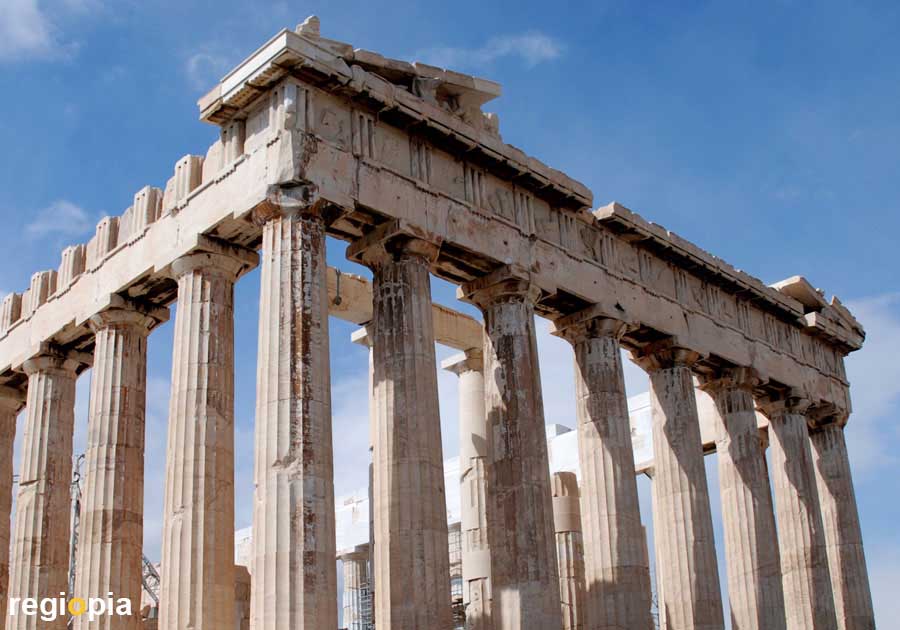
Parthenon Temple
The Parthenon was founded in 438 BC. Built as a temple for the city goddess Athena. The occasion was the victory in 480 BC. over the Persians. In this war the old Athena Temple was destroyed by the Persians along with all other buildings on the Acropolis. According to Greek mythology, the goddess "Pallas Athene" is the goddess of wisdom, combat, strategy and the arts. Athena is one of the 12 Olympic deities. "Parthenon" means maiden chamber. 2 to 4 virgins "Arrephoroi" served as temple servants in the Parthenon Temple. Perikles commissioned the architects Iktinos and Kallikrates for the temple, while the sculptor Phidias created the sculptures.
The Parthenon is a temple of Doric order with 8 columns on the front side and 17 columns on the long side. The temple had two rooms (cella and parthenon) each with its own entrance and separated by a wall. The cult hall of the temple "Cella" with the statue of Athena had another U-shaped colonnade inside. A replica of Athena is in the National Archaeological Museum. The "Parthenon" was the room of the priestess and her virgin servants.
The frieze relief of the Parthenon Temple was knocked off by the British Earl of Elgin in 1801 and brought to London. The art theft of the "Elgin Marbles" is still causing tension between Greece and Great Britain. If you want to see the stolen relief, you have to go to the British Museum. The rest of the relief is exhibited in the Acropolis Museum. After the end of antiquity, the Parthenon Temple was converted into a church. Under the Ottomans, the temple was used as a mosque and ammunition depot. The powder depot exploded in an attack and destroyed the temple. The Parthenon temple has been partially rebuilt since Greece gained independence.
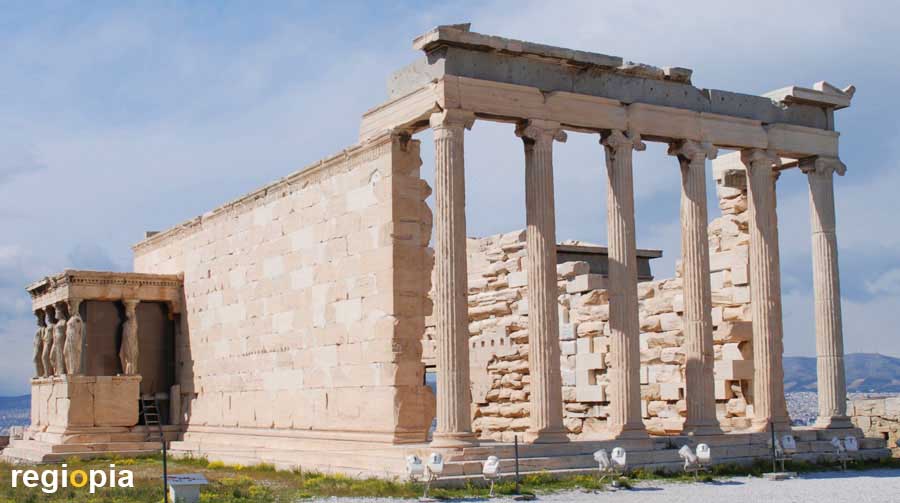
Erechtheion
The Erechtheion was built around 406 BC. in the Ionic style. It served as a temple for several gods and heroes. In the Erechtheion there was also the crevice in which the sacred serpent of the city goddess Athena lived. A wooden figure of Athena also stood here. The special feature of the Erechtheion is the vestibule, which is supported by six female sculptures, the Caryatids. The temple was named after Erechtheus, the mythological king of Attica, who is said to have had his palace here. Erechtheus was the son of Hephaestus, the god of fire and Gaia the earth goddess. Erechtheus had a human upper body and a snake-like lower body. Since he had no legs, he is said to have invented the wheel.
From the 7th century the Erechtheion was used as a church and the Ottomans made a harem out of the temple in 1456. In 1801 the Earl of Elgin stole one of the Caryatids and brought it to London, since then the sculpture is in the British Museum. The Caryatids that remained in Athens are now in the Acropolis Museum.
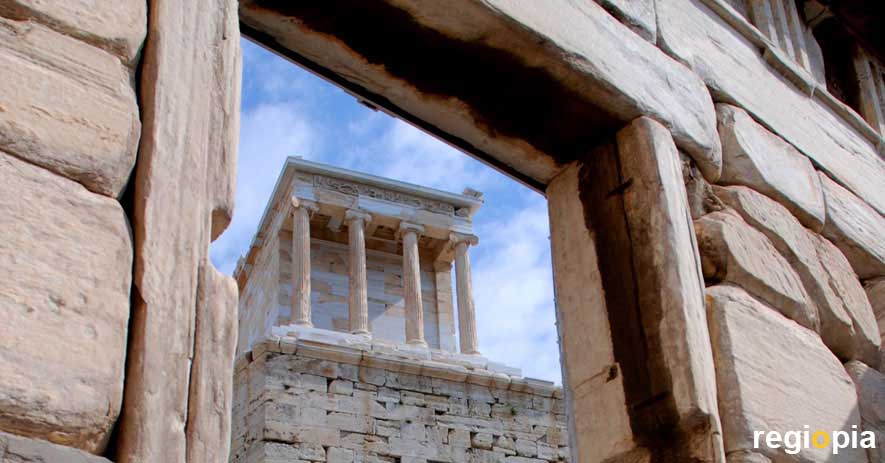
Nike Temple
The temple of the goddess of victory Nike was distroyed by the Persians in 480 BC. and around 410 BC. rebuilt by the victorious Greeks. With a floor space of only 5.4 x 8.3 m, it is a very small temple. There were 4 columns on each of the gable ends, the statue of Nike stood in the chancel. The Ottomans dismantled the temple in 1687 and used the material to fortify their bulwark. In 1836 the temple was rebuilt with the recovered stones. The goddess Nike was depicted by the Greeks without wings. In many cities you can find victory columns on which Nike is depicted with wings. The Victory Column in Berlin is a good example of this. A sporting goods manufacturer from Portland has named its company after the Greek goddess of victory.
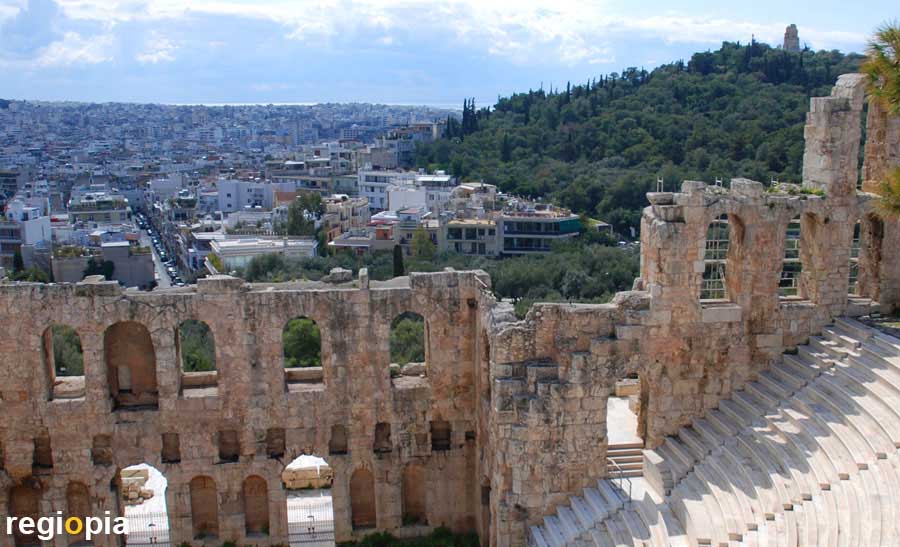
Herodes Theater
The "Herod Theater" was founded in 161 AD by Herod Atticus, a Greco-Roman politician in memory of his just deceased wife. His wife Anna Regilla was a high priestess who was murdered the previous year. Some people claimed that he had murdered his wife himself.

Kentriki Agora
The Central Market Hall "Kentriki Agora" is the belly of Athens, here you can find all the smells of the city. The simple hall of cast iron was built in 1880. A visit is worthwhile because of the special atmosphere.
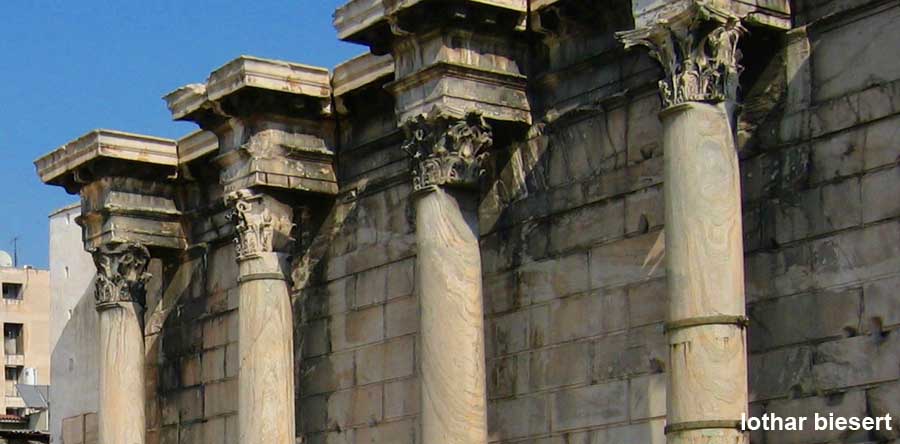
Library of Hadrian
The Roman Emperor Hadrian donated the Library in 132 AD. The building was destroyed in 267 by an attack by the Herulians. It is assumed that the library built around a courtyard, had the function of a university.
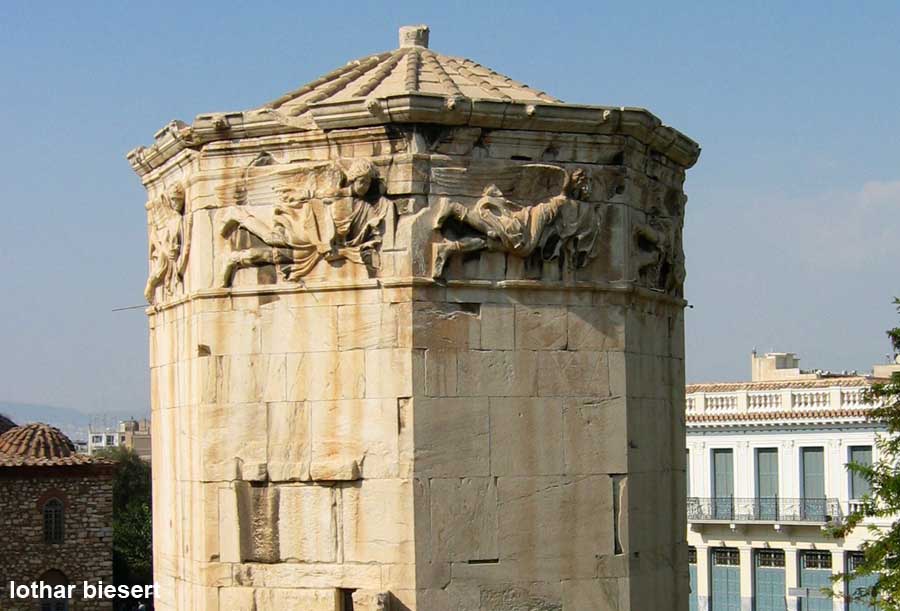
Tower of Winds
The octagonal tower was built around 50 BC by the Greek astronomer Andronikos as a measuring station. On the roof there was a weather banner in the form of the sea god "Triton". On all eight sides, sundials were installed and there was a water clock inside the tower. The relief below the Attica shows the 8 Windgods (Anemoi). An interesting reinterpretation of the "Tower of the Winds" was built in Yokohama by Toyo Ito.
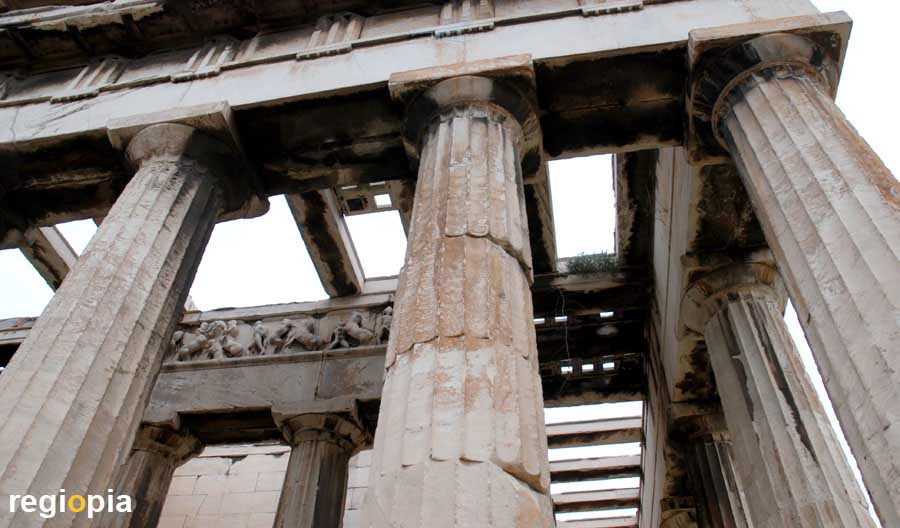
Temple of Hephaestus
The construction of the "Temple of Hephaestus" started around 449 BC, the works could be finished in 415 BC. The Temple of Hephaestus was consecrated to the god of smithy. The Doric ring-shaped temple made of marble is one of the best preserved Greek temples.
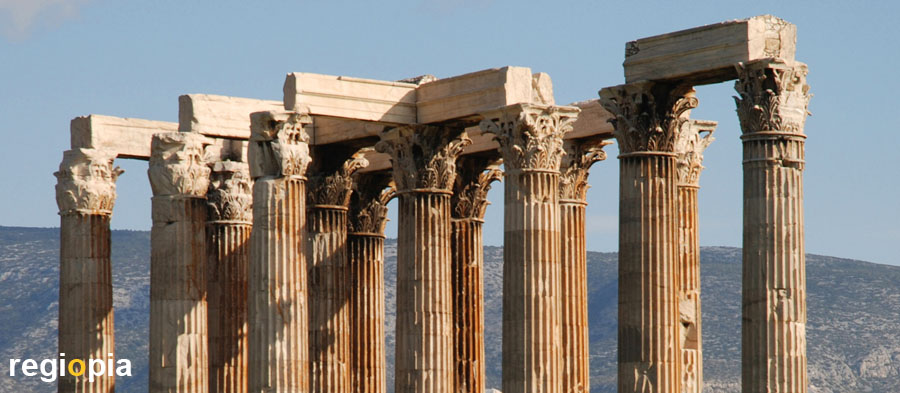
Temple of Zeus
The construction of the Zeus Temple began around 550 BC but the structure was completed under Emperor Hadrian, around 130 AD. The huge temple with a double row of columns, over 100 meters long, was probably destroyed by an earthquake. Zeus was the supreme god of Greek mythology and stronger than all other gods combined. Therefore the Zeus temple was bigger than any other temple. The Parthenon Temple on the Acropolis was significantly smaller at 70 m in length. The Zeus Temple in Athens has Corinthian capitals that can still be seen today. Even if the temple was destroyed you can still see the huge dimensions.
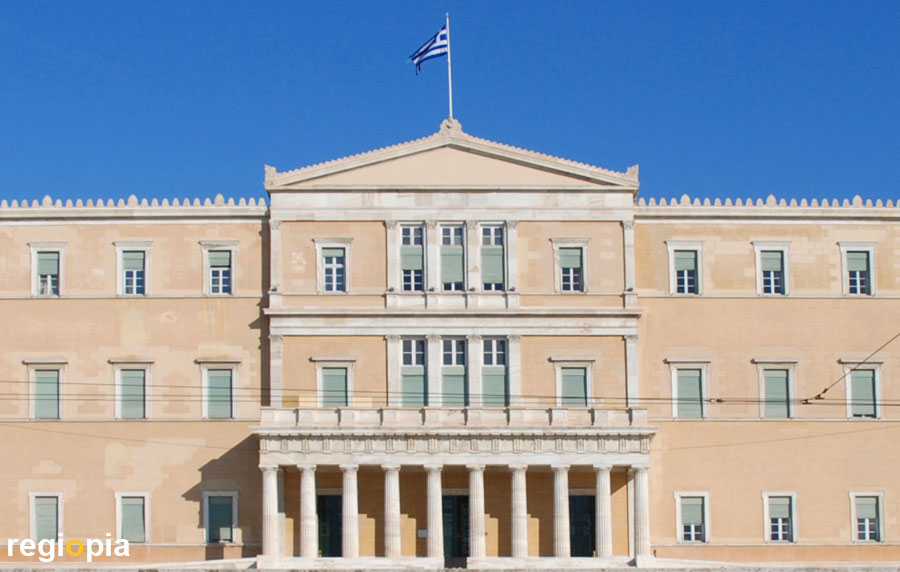
Parliament of Greece
The Greek Parliament was built in 1842 as the residence of King Otto. Since 1935 the neoclassical building serves as a parliament. The changing of the guard every hour, is an interesting spectacle in front of the parliament.
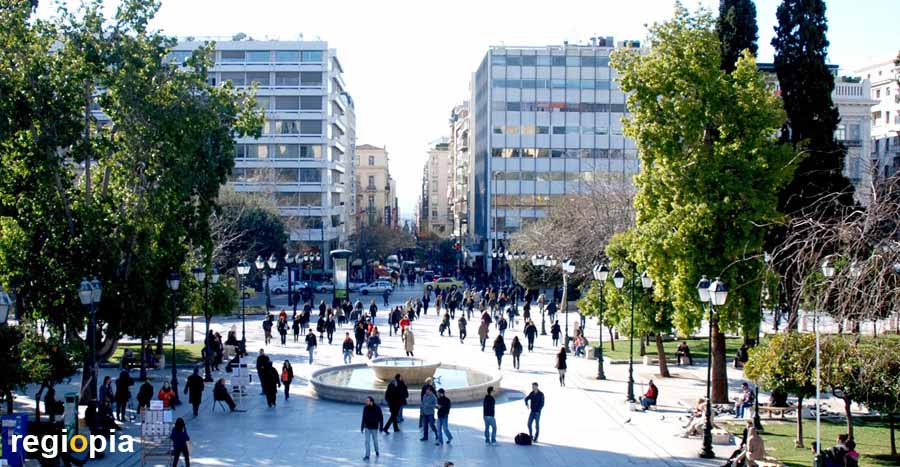
Syntagma Square
The Square of the Constitution is the center of Athens, where the pedestrian zone "Ermou" begins, where international hotels and the Parliament building are located. In the Syntagma metro station, archaeological finds are displayed, which were discovered during the construction of the station.
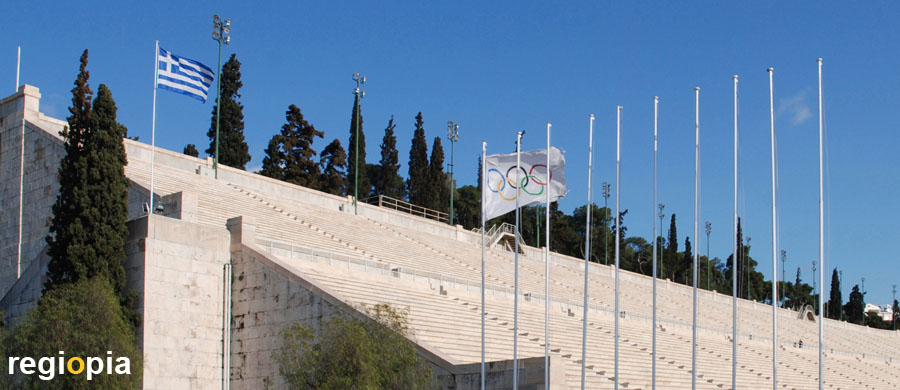
Panathinaiko Stadium
The "Panathinaiko Stadium" was built for the first Olympic Games, of the modern era in 1896. It stands on the same place, as the ancient stadium of Athens.
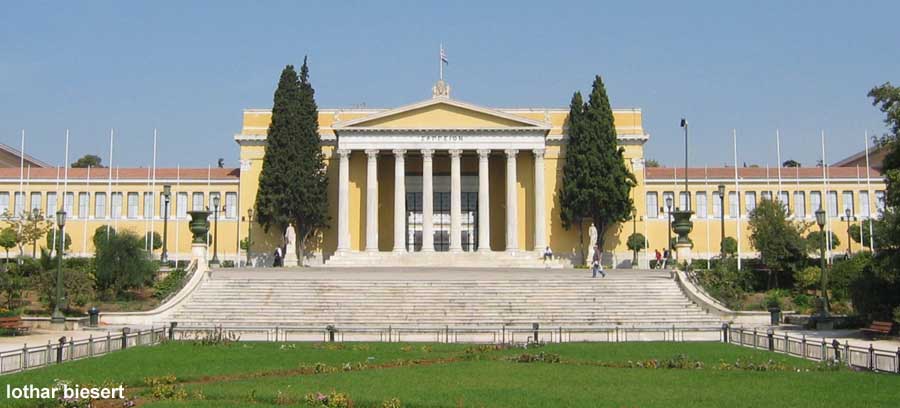
Zappeion
The neoclassical exhibition hall was erected in 1888 by the German architects Hansen and Ziller. The freedom fighter and prosperous businessman Evangelos Zappas donated the building. The beautiful courtyard is worth a visit.
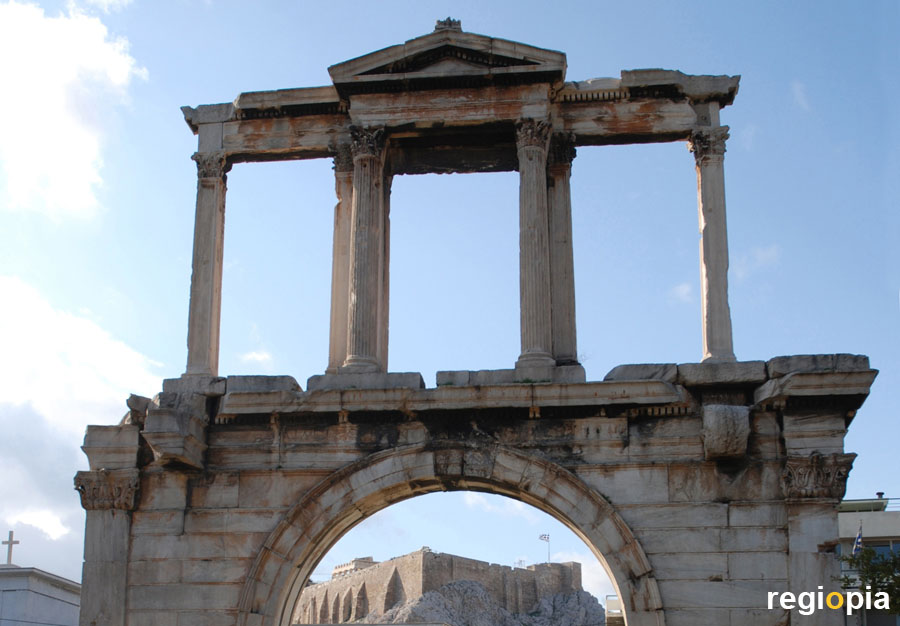
Hadrians Arch
The "Hadrian Gate" marked the transition from the ancient Greek city to the new Roman city of Hadrian. Hadrian was the fourteenth Emperor of Rome and ruled the world empire from 117-138 AD. He was a great admirer of the Greek culture and promoted Athens in a very special way. The Hadrian's Arch built around 131 AD is located near the Temple of Zeus, completed under Hadrian.
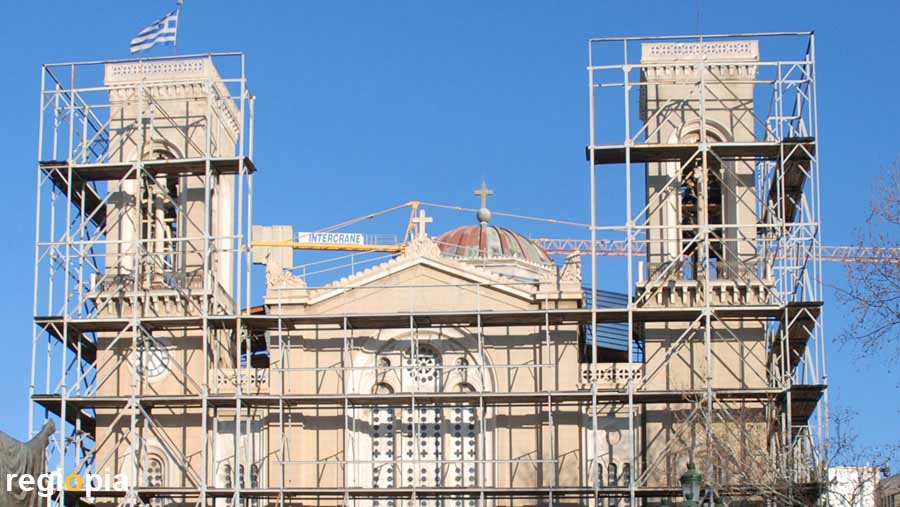
Megali Mitropoli
The "Metropolitan Cathedral" was built in 1862 under the rule of King Otto I, as the largest church in Athens. The Annunciation Cathedral was designed by the Danish architect Hansen, in neo-Byzantine style. Next to the "Megali Mitropoli", stands the much older "Mikri Mitropoli".
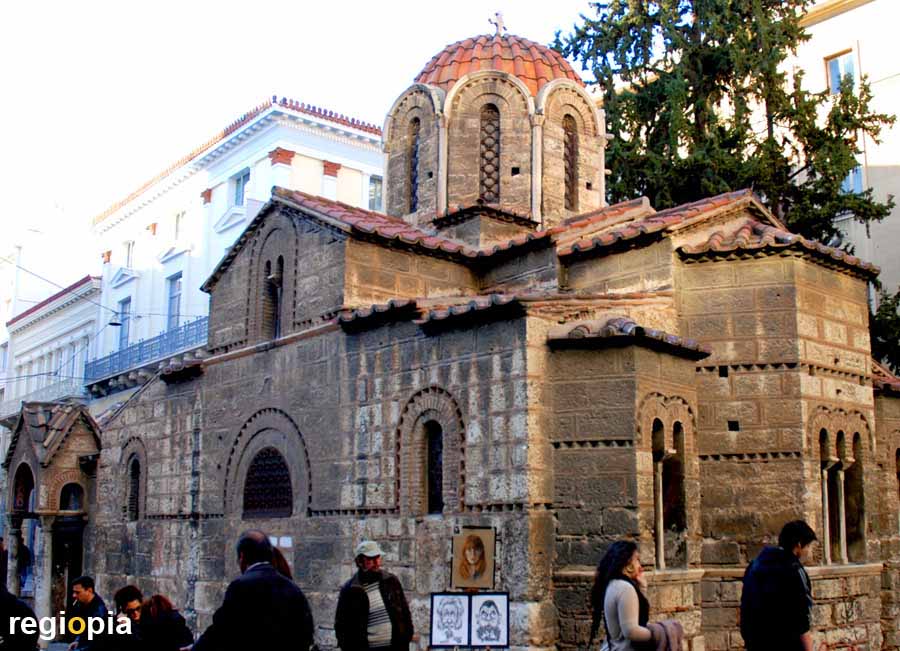
Kapnikarea Church
In the middle of the pedestrian zone "Ermou" stands the Byzantine church from the 11th century. In 1834, the church was supposed to give way to the construction of the Ermou Street, but the plans were changed in the short term and the Kapnikarea Church was preserved.
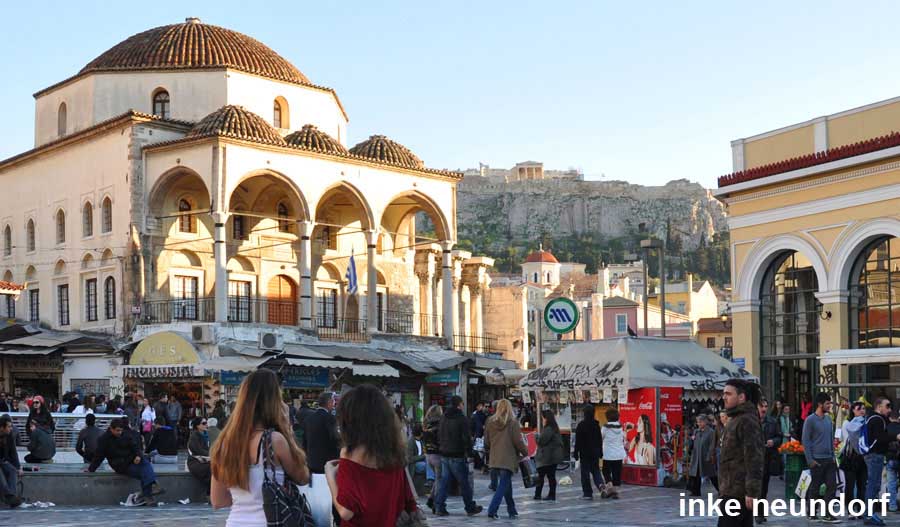
Tsisdarakis Mosque
The Ottomans built the Tsisdarakis Mosque in 1759. The architect Mustafa Tsistarakis destroyed ancient columns for the construction, which led to his dismissal. After the independence, the minaret was demolished. Since then, the mosque is used as a museum.
Map of sights in Athens
ads
Travelguide Athens
Welcome to Athens
No other city has shaped Europe as much as Athens. This is where the democracy, science and architecture of Europe emerged. The buildings in Rome were modeled on Athens and Paris on the model of Rome. In the classicism of the 19th century, Greek architecture even spread all over the world. Athens is therefore considered the first major city in Europe.
Today Athens is the capital of Greece with around 3.8 million inhabitants. Athens offers a lot of famous buildings and great museums, like the National Archaeological Museum or the Acropolis Museum.
ads
Discover Athens
Athens has grown together with the port city of Piraeus. You can get to the port quickly by underground. From here you can take the ferries to the Greek Islands. A tram goes from Athens city center to the sea, the route runs along the coast, pasing several beaches.


